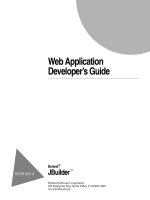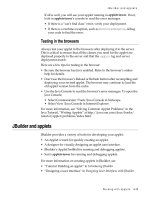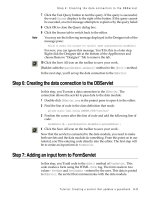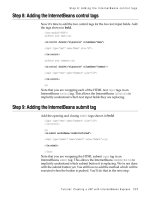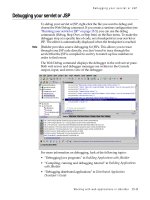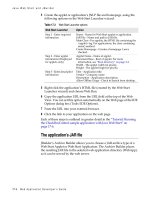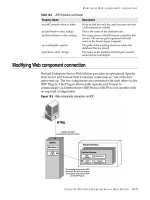ARM System Developer’s Guide phần 2 ppsx
Bạn đang xem bản rút gọn của tài liệu. Xem và tải ngay bản đầy đủ của tài liệu tại đây (466.22 KB, 70 trang )
58 Chapter 3 Introduction to the ARM Instruction Set
The number of cycles taken to execute a multiply instruction depends on the processor
implementation. For some implementations the cycle timing also depends on the value
in Rs. For more details on cycle timings, see Appendix D.
Example
3.11
This example shows a simple multiply instruction that multiplies registers r1 and r2 together
and places the result into register r0. In this example, register r1 is equal to the value 2, and
r2 is equal to 2. The result, 4, is then placed into register r0.
PRE r0 = 0x00000000
r1 = 0x00000002
r2 = 0x00000002
MUL r0, r1, r2 ; r0 = r1*r2
POST r0 = 0x00000004
r1 = 0x00000002
r2 = 0x00000002
■
The long multiply instructions (SMLAL, SMULL, UMLAL, and UMULL) produce a 64-bit
result. The result is too large to fit a single 32-bit register so the result is placed in two
registers labeled RdLo and RdHi. RdLo holds the lower 32 bits of the 64-bit result, and
RdHi holds the higher 32 bits of the 64-bit result. Example 3.12 shows an example of a long
unsigned multiply instruction.
Example
3.12
The instruction multiplies registers r2 and r3 and places the result into register r0 and r1.
Register r0 contains the lower 32 bits, and register r1 contains the higher 32 bits of the
64-bit result.
PRE r0 = 0x00000000
r1 = 0x00000000
r2 = 0xf0000002
r3 = 0x00000002
UMULL r0, r1, r2, r3 ; [r1,r0] = r2*r3
POST r0 = 0xe0000004 ; = RdLo
r1 = 0x00000001 ; = RdHi
■
3.2 Branch Instructions
A branch instruction changes the flow of execution or is used to call a routine. This type
of instruction allows programs to have subroutines, if-then-else structures, and loops.
3.2 Branch Instructions 59
The change of execution flow forces the program counter pc to point to a new address.
The ARMv5E instruction set includes four different branch instructions.
Syntax: B{<cond>} label
BL{<cond>} label
BX{<cond>} Rm
BLX{<cond>} label | Rm
B branch pc = label
BL branch with link pc = label
lr = address of the next instruction after the BL
BX
branch exchange pc = Rm & 0xfffffffe, T = Rm &1
BLX branch exchange with link pc = label, T =1
pc = Rm & 0xfffffffe, T = Rm &1
lr = address of the next instruction after the BLX
The address label is stored in the instruction as a signed pc-relative offset and must be
within approximately 32 MB of the branch instruction. T refers to the Thumb bit in the
cpsr. When instructions set T, the ARM switches to Thumb state.
Example
3.13
This example shows a forward and backward branch. Because these loops are address
specific, we do not include the pre- and post-conditions. The forward branch skips three
instructions. The backward branch creates an infinite loop.
B forward
ADD r1, r2, #4
ADD r0, r6, #2
ADD r3, r7, #4
forward
SUB r1, r2, #4
backward
ADD r1, r2, #4
SUB r1, r2, #4
ADD r4, r6, r7
B backward
Branches are used to change execution flow. Most assemblers hide the details of a branch
instruction encoding by using labels. In this example, forward and backward are the labels.
The branch labels are placed at the beginning of the line and are used to mark an address
that can be used later by the assembler to calculate the branch offset. ■
60 Chapter 3 Introduction to the ARM Instruction Set
Example
3.14
The branch with link, or BL, instruction is similar to the B instruction but overwrites the
link register lr with a return address. It performs a subroutine call. This example shows
a simple fragment of code that branches to a subroutine using the BL instruction. To return
from a subroutine, you copy the link register to the pc.
BL subroutine ; branch to subroutine
CMP r1, #5 ; compare r1 with 5
MOVEQ r1, #0 ; if (r1==5) then r1 = 0
:
subroutine
<subroutine code>
MOV pc, lr ; return by moving pc = lr
The branch exchange (BX) and branch exchange with link (BLX) are the third type of
branch instruction. The BX instruction uses an absolute address stored in register Rm.It
is primarily used to branch to and from Thumb code, as shown in Chapter 4. The T bit
in the cpsr is updated by the least significant bit of the branch register. Similarly the BLX
instruction updates the T bit of the cpsr with the least significant bit and additionally sets
the link register with the return address. ■
3.3 Load-Store Instructions
Load-store instructions transfer data between memory and processor registers. There are
three types of load-store instructions: single-register transfer, multiple-register transfer,
and swap.
3.3.1 Single-Register Transfer
These instructions are used for moving a single data item in and out of a register. The
datatypes supported are signed and unsigned words (32-bit), halfwords (16-bit), and bytes.
Here are the various load-store single-register transfer instructions.
Syntax: <LDR|STR>{<cond>}{B} Rd,addressing
1
LDR{<cond>}SB|H|SH Rd, addressing
2
STR{<cond>}H Rd, addressing
2
LDR load word into a register Rd <- mem32[address]
STR save byte or word from a register Rd -> mem32[address]
LDRB load byte into a register Rd <- mem8[address]
STRB save byte from a register Rd -> mem8[address]
3.3 Load-Store Instructions 61
LDRH load halfword into a register Rd <- mem16[address]
STRH save halfword into a register Rd -> mem16[address]
LDRSB load signed byte into a register Rd <- SignExtend
(mem8[address])
LDRSH load signed halfword into a register Rd <- SignExtend
(mem16[address])
Tables 3.5 and 3.7, to be presented is Section 3.3.2, describe the addressing
1
and addressing
2
syntax.
Example
3.15
LDR and STR instructions can load and store data on a boundary alignment that is the same
as the datatype size being loaded or stored. For example, LDR can only load 32-bit words on
a memory address that is a multiple of four bytes—0, 4, 8, and so on. This example shows
a load from a memory address contained in register r1, followed by a store back to the same
address in memory.
;
; load register r0 with the contents of
; the memory address pointed to by register
; r1.
;
LDR r0, [r1] ; = LDR r0, [r1, #0]
;
; store the contents of register r0 to
; the memory address pointed to by
; register r1.
;
STR r0, [r1] ; = STR r0, [r1, #0]
The first instruction loads a word from the address stored in register r1 and places it into
register r0. The second instruction goes the other way by storing the contents of register
r0 to the address contained in register r1. The offset from register r1 is zero. Register r1 is
called the base address register. ■
3.3.2 Single-Register Load-Store Addressing Modes
The ARM instruction set provides different modes for addressing memory. These modes
incorporate one of the indexing methods: preindex with writeback, preindex, and postindex
(see Table 3.4).
62 Chapter 3 Introduction to the ARM Instruction Set
Table 3.4 Index methods.
Base address
Index method Data register Example
Preindex with writeback mem[base + offset] base + offset LDR r0,[r1,#4]!
Preindex mem[base + offset] not updated LDR r0,[r1,#4]
Postindex mem[base] base + offset LDR r0,[r1],#4
Note: ! indicates that the instruction writes the calculated address back to the base address register.
Example
3.16
Preindex with writeback calculates an address from a base register plus address offset and
then updates that address base register with the new address. In contrast, the preindex offset
is the same as the preindex with writeback but does not update the address base register.
Postindex only updates the address base register after the address is used. The preindex
mode is useful for accessing an element in a data structure. The postindex and preindex
with writeback modes are useful for traversing an array.
PRE r0 = 0x00000000
r1 = 0x00090000
mem32[0x00009000] = 0x01010101
mem32[0x00009004] = 0x02020202
LDR r0, [r1, #4]!
Preindexing with writeback:
POST(1) r0 = 0x02020202
r1 = 0x00009004
LDR r0, [r1, #4]
Preindexing:
POST(2) r0 = 0x02020202
r1 = 0x00009000
LDR r0, [r1], #4
Postindexing:
POST(3) r0 = 0x01010101
r1 = 0x00009004
3.3 Load-Store Instructions 63
Table 3.5
Single-register load-store addressing, word or unsigned byte.
Addressing
1
mode and index method Addressing
1
syntax
Preindex with immediate offset [Rn, #+/-offset_12]
Preindex with register offset [Rn, +/-Rm]
Preindex with scaled register offset [Rn, +/-Rm, shift #shift_imm]
Preindex writeback with immediate offset [Rn, #+/-offset_12]!
Preindex writeback with register offset [Rn, +/-Rm]!
Preindex writeback with scaled register offset [Rn, +/-Rm, shift #shift_imm]!
Immediate postindexed [Rn], #+/-offset_12
Register postindex [Rn], +/-Rm
Scaled register postindex [Rn], +/-Rm, shift #shift_imm
Example 3.15 used a preindex method. This example shows how each indexing method
effects the address held in register r1, as well as the data loaded into register r0. Each
instruction shows the result of the index method with the same pre-condition. ■
The addressing modes available with a particular load or store instruction depend on
the instruction class. Table 3.5 shows the addressing modes available for load and store of
a 32-bit word or an unsigned byte.
A signed offset or register is denoted by “+/−”, identifying that it is either a positive or
negative offset from the base address register Rn. The base address register is a pointer to
a byte in memory, and the offset specifies a number of bytes.
Immediate means the address is calculated using the base address register and a 12-bit
offset encoded in the instruction. Register means the address is calculated using the base
address register and a specific register’s contents. Scaled means the address is calculated
using the base address register and a barrel shift operation.
Table 3.6 provides an example of the different variations of the LDR instruction. Table 3.7
shows the addressing modes available on load and store instructions using 16-bit halfword
or signed byte data.
These operations cannot use the barrel shifter. There are no STRSB or STRSH instructions
since STRH stores both a signed and unsigned halfword; similarly STRB stores signed and
unsigned bytes. Table 3.8 shows the variations for STRH instructions.
3.3.3 Multiple-Register Transfer
Load-store multiple instructions can transfer multiple registers between memory and the
processor in a single instruction. The transfer occurs from a base address register Rn pointing
into memory. Multiple-register transfer instructions are more efficient from single-register
transfers for moving blocks of data around memory and saving and restoring context and
stacks.
64 Chapter 3 Introduction to the ARM Instruction Set
Table 3.6 Examples of LDR instructions using different addressing modes.
Instruction r0 = r1 +=
Preindex LDR r0,[r1,#0x4]! mem32[r1 + 0x4] 0x4
with
writeback
LDR r0,[r1,r2]! mem32[r1+r2] r2
LDR r0,[r1,r2,LSR#0x4]! mem32[r1 + (r2 LSR 0x4)] (r2 LSR 0x4)
Preindex LDR r0,[r1,#0x4] mem32[r1 + 0x4] not updated
LDR r0,[r1,r2] mem32[r1 + r2] not updated
LDR r0,[r1,-r2,LSR #0x4] mem32[r1-(r2 LSR 0x4)] not updated
Postindex LDR r0,[r1],#0x4 mem32[r1] 0x4
LDR r0,[r1],r2 mem32[r1] r2
LDR r0,[r1],r2,LSR #0x4 mem32[r1] (r2 LSR 0x4)
Table 3.7 Single-register load-store addressing, halfword, signed halfword, signed byte, and
doubleword.
Addressing
2
mode and index method Addressing
2
syntax
Preindex immediate offset [Rn, #+/-offset_8]
Preindex register offset [Rn, +/-Rm]
Preindex writeback immediate offset [Rn, #+/-offset_8]!
Preindex writeback register offset [Rn, +/-Rm]!
Immediate postindexed [Rn], #+/-offset_8
Register postindexed [Rn], +/-Rm
Table 3.8 Variations of STRH instructions.
Instruction Result r1 +=
Preindex with STRH r0,[r1,#0x4]! mem16[r1+0x4]=r0 0x4
writeback
STRH r0,[r1,r2]! mem16[r1+r2]=r0 r2
Preindex STRH r0,[r1,#0x4] mem16[r1+0x4]=r0 not updated
STRH r0,[r1,r2] mem16[r1+r2]=r0 not updated
Postindex STRH r0,[r1],#0x4 mem16[r1]=r0 0x4
STRH r0,[r1],r2 mem16[r1]=r0 r2
3.3 Load-Store Instructions 65
Load-store multiple instructions can increase interrupt latency. ARM implementations
do not usually interrupt instructions while they are executing. For example, on an ARM7
a load multiple instruction takes 2 + Nt cycles, where N is the number of registers to load
and t is the number of cycles required for each sequential access to memory. If an interrupt
has been raised, then it has no effect until the load-store multiple instruction is complete.
Compilers, such as armcc, provide a switch to control the maximum number of registers
being transferred on a load-store, which limits the maximum interrupt latency.
Syntax: <LDM|STM>{<cond>}<addressing mode> Rn{!},<registers>{ˆ}
LDM load multiple registers {Rd}
∗N
<- mem32[start address + 4
∗
N] optional Rn updated
STM save multiple registers {Rd}
∗N
-> mem32[start address + 4
∗
N] optional Rn updated
Table 3.9 shows the different addressing modes for the load-store multiple instructions.
Here N is the number of registers in the list of registers.
Any subset of the current bank of registers can be transferred to memory or fetched
from memory. The base register Rn determines the source or destination address for a load-
store multiple instruction. This register can be optionally updated following the transfer.
This occurs when register Rn is followed by the ! character, similiar to the single-register
load-store using preindex with writeback.
Table 3.9 Addressing mode for load-store multiple instructions.
Addressing
mode Description Start address End address Rn!
IA increment after Rn Rn +4
∗
N − 4 Rn + 4
∗
N
IB increment before Rn + 4 Rn + 4
∗
NRn+ 4
∗
N
DA decrement after Rn − 4
∗
N + 4 Rn Rn − 4
∗
N
DB decrement before Rn − 4
∗
NRn− 4 Rn − 4
∗
N
Example
3.17
In this example, register r0 is the base register Rn and is followed by !, indicating that the
register is updated after the instruction is executed. You will notice within the load multiple
instruction that the registers are not individually listed. Instead the “-” character is used to
identify a range of registers. In this case the range is from register r1 to r3 inclusive.
Each register can also be listed, using a comma to separate each register within
“{” and “}” brackets.
PRE mem32[0x80018] = 0x03
mem32[0x80014] = 0x02
66 Chapter 3 Introduction to the ARM Instruction Set
mem32[0x80010] = 0x01
r0 = 0x00080010
r1 = 0x00000000
r2 = 0x00000000
r3 = 0x00000000
LDMIA r0!, {r1-r3}
POST r0 = 0x0008001c
r1 = 0x00000001
r2 = 0x00000002
r3 = 0x00000003
Figure 3.3 shows a graphical representation.
The base register r0 points to memory address 0x80010 in the PRE condition. Memory
addresses 0x80010, 0x80014, and 0x80018 contain the values 1, 2, and 3 respectively. After
the load multiple instruction executes registers r1, r2, and r3 contain these values as shown
in Figure 3.4. The base register r0 now points to memory address 0x8001c after the last
loaded word.
Now replace the LDMIA instruction with a load multiple and increment before LDMIB
instruction and use the same PRE conditions. The first word pointed to by register r0 is
ignored and register r1 is loaded from the next memory location as shown in Figure 3.5.
After execution, register r0 now points to the last loaded memory location. This is in
contrast with the LDMIA example, which pointed to the next memory location. ■
The decrement versions DA and DB of the load-store multiple instructions decrement the
start address and then store to ascending memory locations. This is equivalent to descending
memory but accessing the register list in reverse order. With the increment and decrement
load multiples, you can access arrays forwards or backwards. They also allow for stack push
and pull operations, illustrated later in this section.
0x80020
0x8001c
0x80018
0x80014
0x80010
0x8000c
0x00000005
0x00000004
0x00000003
0x00000002
0x00000001
0x00000000
r3 = 0x00000000
r2 = 0x00000000
r1 = 0x00000000
r0 = 0x80010
Memory
addressAddress pointer Data
Figure 3.3 Pre-condition for LDMIA instruction.
3.3 Load-Store Instructions 67
0x80020
0x8001c
0x80018
0x80014
0x80010
0x8000c
0x00000005
0x00000004
0x00000003
0x00000002
0x00000001
0x00000000
r3 = 0x00000003
r2 = 0x00000002
r1 = 0x00000001
r0 = 0x8001c
Memory
addressAddress pointer Data
Figure 3.4 Post-condition for LDMIA instruction.
0x80020
0x8001c
0x80018
0x80014
0x80010
0x8000c
0x00000005
0x00000004
0x00000003
0x00000002
0x00000001
0x00000000
r3 = 0x00000004
r2 = 0x00000003
r1 = 0x00000002
r0 = 0x8001c
Memory
addressAddress pointer Data
Figure 3.5 Post-condition for LDMIB instruction.
Table 3.10 Load-store multiple pairs when base update used.
Store multiple Load multiple
STMIA LDMDB
STMIB LDMDA
STMDA LDMIB
STMDB LDMIA
Table 3.10 shows a list of load-store multiple instruction pairs. If you use a store with
base update, then the paired load instruction of the same number of registers will reload
the data and restore the base address pointer. This is useful when you need to temporarily
save a group of registers and restore them later.
68 Chapter 3 Introduction to the ARM Instruction Set
Example
3.18
This example shows an STM increment before instruction followed by an LDM decrement after
instruction.
PRE r0 = 0x00009000
r1 = 0x00000009
r2 = 0x00000008
r3 = 0x00000007
STMIB r0!, {r1-r3}
MOV r1, #1
MOV r2, #2
MOV r3, #3
PRE(2) r0 = 0x0000900c
r1 = 0x00000001
r2 = 0x00000002
r3 = 0x00000003
LDMDA r0!, {r1-r3}
POST r0 = 0x00009000
r1 = 0x00000009
r2 = 0x00000008
r3 = 0x00000007
The STMIB instruction stores the values 7, 8, 9 to memory. We then corrupt register r1 to r3.
The LDMDA reloads the original values and restores the base pointer r0. ■
Example
3.19
We illustrate the use of the load-store multiple instructions with a block memory copy
example. This example is a simple routine that copies blocks of 32 bytes from a source
address location to a destination address location.
The example has two load-store multiple instructions, which use the same increment
after addressing mode.
; r9 points to start of source data
; r10 points to start of destination data
; r11 points to end of the source
loop
; load 32 bytes from source and update r9 pointer
LDMIA r9!, {r0-r7}
3.3 Load-Store Instructions 69
; store 32 bytes to destination and update r10 pointer
STMIA r10!, {r0-r7} ; and store them
; have we reached the end
CMP r9, r11
BNE loop
This routine relies on registers r9, r10, and r11 being set up before the code is executed.
Registers r9 and r11 determine the data to be copied, and register r10 points to the desti-
nation in memory for the data. LDMIA loads the data pointed to by register r9 into registers
r0 to r7. It also updates r9 to point to the next block of data to be copied. STMIA copies the
contents of registers r0 to r7 to the destination memory address pointed to by register r10.
It also updates r10 to point to the next destination location. CMP and BNE compare pointers
r9 and r11 to check whether the end of the block copy has been reached. If the block copy
is complete, then the routine finishes; otherwise the loop repeats with the updated values
of register r9 and r10.
The BNE is the branch instruction B with a condition mnemonic NE (not equal). If the
previous compare instruction sets the condition flags to not equal, the branch instruction
is executed.
Figure 3.6 shows the memory map of the block memory copy and how the routine
moves through memory. Theoretically this loop can transfer 32 bytes (8 words) in two
instructions, for a maximum possible throughput of 46 MB/second being transferred at
33 MHz. These numbers assume a perfect memory system with fast memory. ■
High memory
Low memory
r11
r9
r10
Source
Destination
Copy
memory
location
Figure 3.6 Block memory copy in the memory map.
70 Chapter 3 Introduction to the ARM Instruction Set
3.3.3.1 Stack Operations
The ARM architecture uses the load-store multiple instructions to carry out stack
operations. The pop operation (removing data from a stack) uses a load multiple instruction;
similarly, the push operation (placing data onto the stack) uses a store multiple instruction.
When using a stack you have to decide whether the stack will grow up or down in
memory. A stack is either ascending (A)ordescending (D). Ascending stacks grow towards
higher memory addresses; in contrast, descending stacks grow towards lower memory
addresses.
When you use a full stack (F), the stack pointer sp points to an address that is the last
used or full location (i.e., sp points to the last item on the stack). In contrast, if you use an
empty stack (E) the sp points to an address that is the first unused or empty location (i.e., it
points after the last item on the stack).
There are a number of load-store multiple addressing mode aliases available to support
stack operations (see Table 3.11). Next to the pop column is the actual load multiple
instruction equivalent. For example, a full ascending stack would have the notation FA
appended to the load multiple instruction—LDMFA. This would be translated into an LDMDA
instruction.
ARM has specified an ARM-Thumb Procedure Call Standard (ATPCS) that defines how
routines are called and how registers are allocated. In the ATPCS, stacks are defined as being
full descending stacks. Thus, the LDMFD and STMFD instructions provide the pop and push
functions, respectively.
Example
3.20
The STMFD instruction pushes registers onto the stack, updating the sp. Figure 3.7 shows
a push onto a full descending stack. You can see that when the stack grows the stack pointer
points to the last full entry in the stack.
PRE r1 = 0x00000002
r4 = 0x00000003
sp = 0x00080014
STMFD sp!, {r1,r4}
Table 3.11 Addressing methods for stack operations.
Addressing mode Description Pop =LDM Push = STM
FA full ascending LDMFA LDMDA STMFA STMIB
FD full descending LDMFD LDMIA STMFD STMDB
EA empty ascending LDMEA LDMDB STMEA STMIA
ED empty descending LDMED LDMIB STMED STMDA
3.3 Load-Store Instructions 71
0x80018
0x80014
0x80010
0x8000c
0x00000001
0x00000002
Empty
Empty
sp
AddressPRE Data
0x80018
0x80014
0x80010
0x8000c
0x00000001
0x00000002
0x00000003
0x00000002
sp
AddressPOST Data
Figure 3.7 STMFD instruction—full stack push operation.
POST r1 = 0x00000002
r4 = 0x00000003
sp = 0x0008000c
■
Example
3.21
In contrast, Figure 3.8 shows a push operation on an empty stack using the STMED instruc-
tion. The STMED instruction pushes the registers onto the stack but updates register sp to
point to the next empty location.
PRE r1 = 0x00000002
r4 = 0x00000003
sp = 0x00080010
STMED sp!, {r1,r4}
POST r1 = 0x00000002
r4 = 0x00000003
sp = 0x00080008
■
0x80018
0x80014
0x80010
0x8000c
0x80008
0x00000001
0x00000002
Empty
Empty
Empty
sp
AddressPRE Data
0x80018
0x80014
0x80010
0x8000c
0x80008
0x00000001
0x00000002
0x00000003
0x00000002
Empty
sp
AddressPOST Data
Figure 3.8 STMED instruction—empty stack push operation.
72 Chapter 3 Introduction to the ARM Instruction Set
When handling a checked stack there are three attributes that need to be preserved: the
stack base, the stack pointer, and the stack limit. The stack base is the starting address of the
stack in memory. The stack pointer initially points to the stack base; as data is pushed onto
the stack, the stack pointer descends memory and continuously points to the top of stack.
If the stack pointer passes the stack limit, then a stack overflow error has occurred. Here is
a small piece of code that checks for stack overflow errors for a descending stack:
; check for stack overflow
SUB sp, sp, #size
CMP sp, r10
BLLO _stack_overflow ; condition
ATPCS defines register r10 as the stack limit or sl. This is optional since it is only used when
stack checking is enabled. The BLLO instruction is a branch with link instruction plus the
condition mnemonic LO.Ifsp is less than register r10 after the new items are pushed onto
the stack, then stack overflow error has occurred. If the stack pointer goes back past the
stack base, then a stack underflow error has occurred.
3.3.4 Swap Instruction
The swap instruction is a special case of a load-store instruction. It swaps the contents of
memory with the contents of a register. This instruction is an atomic operation—it reads
and writes a location in the same bus operation, preventing any other instruction from
reading or writing to that location until it completes.
Syntax: SWP{B}{<cond>} Rd,Rm,[Rn]
SWP swap a word between memory and a register tmp = mem32[Rn]
mem32[Rn] = Rm
Rd = tmp
SWPB swap a byte between memory and a register tmp = mem8[Rn]
mem8[Rn] = Rm
Rd = tmp
Swap cannot be interrupted by any other instruction or any other bus access. We say
the system “holds the bus” until the transaction is complete.
Example
3.22
The swap instruction loads a word from memory into register r0 and overwrites the memory
with register r1.
3.4 Software Interrupt Instruction 73
PRE mem32[0x9000] = 0x12345678
r0 = 0x00000000
r1 = 0x11112222
r2 = 0x00009000
SWP r0, r1, [r2]
POST mem32[0x9000] = 0x11112222
r0 = 0x12345678
r1 = 0x11112222
r2 = 0x00009000
This instruction is particularly useful when implementing semaphores and mutual
exclusion in an operating system. You can see from the syntax that this instruction can also
have a byte size qualifier B, so this instruction allows for both a word and a byte swap. ■
Example
3.23
This example shows a simple data guard that can be used to protect data from being written
by another task. The SWP instruction “holds the bus” until the transaction is complete.
spin
MOV r1, =semaphore
MOV r2, #1
SWP r3, r2, [r1] ; hold the bus until complete
CMP r3, #1
BEQ spin
The address pointed to by the semaphore either contains the value 0 or 1. When the
semaphore equals 1, then the service in question is being used by another process. The
routine will continue to loop around until the service is released by the other process—in
other words, when the semaphore address location contains the value 0. ■
3.4 Software Interrupt Instruction
A software interrupt instruction (SWI) causes a software interrupt exception, which provides
a mechanism for applications to call operating system routines.
Syntax: SWI{<cond>} SWI_number
SWI software interrupt lr_svc =address of instruction following the SWI
spsr_svc =cpsr
pc =vectors +0x8
cpsr mode =SVC
cpsr I =1 (mask IRQ interrupts)
74 Chapter 3 Introduction to the ARM Instruction Set
When the processor executes an SWI instruction, it sets the program counter pc to the
offset 0x8 in the vector table. The instruction also forces the processor mode to SVC, which
allows an operating system routine to be called in a privileged mode.
Each SWI instruction has an associated SWI number, which is used to represent
a particular function call or feature.
Example
3.24
Here we have a simple example of an SWI call with SWI number 0x123456, used by ARM
toolkits as a debugging SWI. Typically the SWI instruction is executed in user mode.
PRE cpsr = nzcVqift_USER
pc = 0x00008000
lr = 0x003fffff; lr = r14
r0 = 0x12
0x00008000 SWI 0x123456
POST cpsr = nzcVqIft_SVC
spsr = nzcVqift_USER
pc = 0x00000008
lr = 0x00008004
r0 = 0x12
Since SWI instructions are used to call operating system routines, you need some form
of parameter passing. This is achieved using registers. In this example, register r0 is used to
pass the parameter 0x12. The return values are also passed back via registers. ■
Code called the SWI handler is required to process the SWI call. The handler obtains
the SWI number using the address of the executed instruction, which is calculated from the
link register lr.
The SWI number is determined by
SWI_Number = <SWI instruction> AND NOT(0xff000000)
Here the SWI instruction is the actual 32-bit SWI instruction executed by the processor.
Example
3.25
This example shows the start of an SWI handler implementation. The code fragment deter-
mines what SWI number is being called and places that number into register r10. You can
see from this example that the load instruction first copies the complete SWI instruction
into register r10. The BIC instruction masks off the top bits of the instruction, leaving the
SWI number. We assume the SWI has been called from ARM state.
SWI_handler
;
; Store registers r0-r12 and the link register
3.5 Program Status Register Instructions 75
;
STMFD sp!, {r0-r12, lr}
; Read the SWI instruction
LDR r10, [lr, #-4]
; Mask off top 8 bits
BIC r10, r10, #0xff000000
; r10 - contains the SWI number
BL service_routine
; return from SWI handler
LDMFD sp!, {r0-r12, pc}ˆ
The number in register r10 is then used by the SWI handler to call the appropriate SWI
service routine. ■
3.5 Program Status Register Instructions
The ARM instruction set provides two instructions to directly control a program status
register (psr). The MRS instruction transfers the contents of either the cpsr or spsr into
a register; in the reverse direction, the MSR instruction transfers the contents of a register
into the cpsr or spsr. Together these instructions are used to read and write the cpsr and spsr.
In the syntax you can see a label called fields. This can be any combination of control
(c), extension (x), status (s), and flags (f ). These fields relate to particular byte regions in
a psr, as shown in Figure 3.9.
Syntax: MRS{<cond>} Rd,<cpsr|spsr>
MSR{<cond>} <cpsr|spsr>_<fields>,Rm
MSR{<cond>} <cpsr|spsr>_<fields>,#immediate
Fields
Bit
31 30 29 28
NZCV
7654 0
IFT Mode
Flags [24:31] Status [16:23] eXtension [8:15] Control [0:7]
Figure 3.9 psr byte fields.
76 Chapter 3 Introduction to the ARM Instruction Set
MRS copy program status register to a general-purpose register Rd =psr
MSR move a general-purpose register to a program status register psr[field] =Rm
MSR move an immediate value to a program status register psr[field] =immediate
The c field controls the interrupt masks, Thumb state, and processor mode.
Example 3.26 shows how to enable IRQ interrupts by clearing the I mask. This opera-
tion involves using both the MRS and MSR instructions to read from and then write to
the cpsr.
Example
3.26
The MSR first copies the cpsr into register r1. The BIC instruction clears bit 7 of r1. Register
r1 is then copied back into the cpsr, which enables IRQ interrupts. You can see from this
example that this code preserves all the other settings in the cpsr and only modifies the I bit
in the control field.
PRE cpsr = nzcvqIFt_SVC
MRS r1, cpsr
BIC r1, r1, #0x80 ; 0b01000000
MSR cpsr_c, r1
POST cpsr = nzcvqiFt_SVC
This example is in SVC mode. In user mode you can read all cpsr bits, but you can only
update the condition flag field f. ■
3.5.1 Coprocessor Instructions
Coprocessor instructions are used to extend the instruction set. A coprocessor can either
provide additional computation capability or be used to control the memory subsystem
including caches and memory management. The coprocessor instructions include data
processing, register transfer, and memory transfer instructions. We will provide only a short
overview since these instructions are coprocessor specific. Note that these instructions are
only used by cores with a coprocessor.
Syntax: CDP{<cond>} cp, opcode1, Cd, Cn {, opcode2}
<MRC|MCR>{<cond>} cp, opcode1, Rd, Cn, Cm {, opcode2}
<LDC|STC>{<cond>} cp, Cd, addressing
3.5 Program Status Register Instructions 77
CDP coprocessor data processing—perform an operation in a coprocessor
MRC MCR coprocessor register transfer—move data to/from coprocessor registers
LDC STC coprocessor memory transfer—load and store blocks of memory to/from a coprocessor
In the syntax of the coprocessor instructions, the cp field represents the coprocessor
number between p0 and p15. The opcode fields describe the operation to take place on
the coprocessor. The Cn, Cm, and Cd fields describe registers within the coprocessor.
The coprocessor operations and registers depend on the specific coprocessor you are
using. Coprocessor 15 (CP15) is reserved for system control purposes, such as memory
management, write buffer control, cache control, and identification registers.
Example
3.27
This example shows a CP15 register being copied into a general-purpose register.
; transferring the contents of CP15 register c0 to register r10
MRC p15, 0, r10, c0, c0, 0
Here CP15 register-0 contains the processor identification number. This register is copied
into the general-purpose register r10. ■
3.5.2 Coprocessor 15 Instruction Syntax
CP15 configures the processor core and has a set of dedicated registers to store configuration
information, as shown in Example 3.27. A value written into a register sets a configuration
attribute—for example, switching on the cache.
CP15 is called the system control coprocessor. Both MRC and MCR instructions are used to
read and write to CP15, where register Rd is the core destination register, Cn is the primary
register, Cm is the secondary register, and opcode2 is a secondary register modifier. You
may occasionally hear secondary registers called “extended registers.”
As an example, here is the instruction to move the contents of CP15 control register c1
into register r1 of the processor core:
MRC p15, 0, r1, c1, c0, 0
We use a shorthand notation for CP15 reference that makes referring to configuration
registers easier to follow. The reference notation uses the following format:
CP15:cX:cY:Z
78 Chapter 3 Introduction to the ARM Instruction Set
The first term, CP15, defines it as coprocessor 15. The second term, after the separating
colon, is the primary register. The primary register X can have a value between 0 and 15.
The third term is the secondary or extended register. The secondary register Y can have
a value between 0 and 15. The last term, opcode2, is an instruction modifier and can have
a value between 0 and 7. Some operations may also use a nonzero value w of opcode1.We
write these as CP15:w:cX:cY:Z.
3.6 Loading Constants
You might have noticed that there is no ARM instruction to move a 32-bit constant into
a register. Since ARM instructions are 32 bits in size, they obviously cannot specify a general
32-bit constant.
To aid programming there are two pseudoinstructions to move a 32-bit value into
a register.
Syntax: LDR Rd, =constant
ADR Rd, label
LDR load constant pseudoinstruction Rd =32-bit constant
ADR load address pseudoinstruction Rd=32-bit relative address
The first pseudoinstruction writes a 32-bit constant to a register using whatever instruc-
tions are available. It defaults to a memory read if the constant cannot be encoded using
other instructions.
The second pseudoinstruction writes a relative address into a register, which will be
encoded using a pc-relative expression.
Example
3.28
This example shows an LDR instruction loading a 32-bit constant 0xff00ffff into
register r0.
LDR r0, [pc, #constant_number-8-{PC}]
:
constant_number
DCD 0xff00ffff
This example involves a memory access to load the constant, which can be expensive for
time-critical routines. ■
Example 3.29 shows an alternative method to load the same constant into register r0 by
using an MVN instruction.
3.7 ARMv5E Extensions 79
Table 3.12 LDR pseudoinstruction conversion.
Pseudoinstruction Actual instruction
LDR r0, =0xff MOV r0, #0xff
LDR r0, =0x55555555 LDR r0, [pc, #offset_12]
Example
3.29
Loading the constant 0xff00ffff using an MVN.
PRE none
MVN r0, #0x00ff0000
POST r0 = 0xff00ffff
■
As you can see, there are alternatives to accessing memory, but they depend upon the
constant you are trying to load. Compilers and assemblers use clever techniques to avoid
loading a constant from memory. These tools have algorithms to find the optimal number
of instructions required to generate a constant in a register and make extensive use of
the barrel shifter. If the tools cannot generate the constant by these methods, then it is
loaded from memory. The LDR pseudoinstruction either inserts an MOV or MVN instruction
to generate a value (if possible) or generates an LDR instruction with a pc-relative address
to read the constant from a literal pool—a data area embedded within the code.
Table 3.12 shows two pseudocode conversions. The first conversion produces a simple
MOV instruction; the second conversion produces a pc-relative load. We recommended that
you use this pseudoinstruction to load a constant. To see how the assembler has handled
a particular load constant, you can pass the output through a disassembler, which will list
the instruction chosen by the tool to load the constant.
Another useful pseudoinstruction is the ADR instruction, or address relative. This instruc-
tion places the address of the given label into register Rd, using a pc-relative add or
subtract.
3.7 ARMv5E Extensions
The ARMv5E extensions provide many new instructions (see Table 3.13). One of the most
important additions is the signed multiply accumulate instructions that operate on 16-bit
data. These operations are single cycle on many ARMv5E implementations.
ARMv5E provides greater flexibility and efficiency when manipulating 16-bit values,
which is important for applications such as 16-bit digital audio processing.
80 Chapter 3 Introduction to the ARM Instruction Set
Table 3.13
New instructions provided by the ARMv5E extensions.
Instruction Description
CLZ {<cond>} Rd, Rm count leading zeros
QADD {<cond>} Rd, Rm, Rn signed saturated 32-bit add
QDADD{<cond>} Rd, Rm, Rn signed saturated double 32-bit add
QDSUB{<cond>} Rd, Rm, Rn signed saturated double 32-bit subtract
QSUB{<cond>} Rd, Rm, Rn signed saturated 32-bit subtract
SMLAxy{<cond>} Rd, Rm, Rs, Rn signed multiply accumulate 32-bit (1)
SMLALxy{<cond>} RdLo, RdHi, Rm, Rs signed multiply accumulate 64-bit
SMLAWy{<cond>} Rd, Rm, Rs, Rn signed multiply accumulate 32-bit (2)
SMULxy{<cond>} Rd, Rm, Rs signed multiply (1)
SMULWy{<cond>} Rd, Rm, Rs signed multiply (2)
3.7.1 Count Leading Zeros Instruction
The count leading zeros instruction counts the number of zeros between the most significant
bit and the first bit set to 1. Example 3.30 shows an example of a CLZ instruction.
Example
3.30
You can see from this example that the first bit set to 1 has 27 zeros preceding it. CLZ is
useful in routines that have to normalize numbers.
PRE r1 = 0b00000000000000000000000000010000
CLZ r0, r1
POST r0 = 27
■
3.7.2 Saturated Arithmetic
Normal ARM arithmetic instructions wrap around when you overflow an integer value.
For example, 0x7fffffff+1=-0x80000000. Thus, when you design an algorithm,
you have to be careful not to exceed the maximum representable value in a 32-bit integer.
Example
3.31
This example shows what happens when the maximum value is exceeded.
PRE cpsr = nzcvqiFt_SVC
r0 = 0x00000000
r1 = 0x70000000 (positive)
r2 = 0x7fffffff (positive)
3.7 ARMv5E Extensions 81
ADDS r0, r1, r2
POST cpsr = NzcVqiFt_SVC
r0 = 0xefffffff (negative)
In the example, registers r1 and r2 contain positive numbers. Register r2 is equal to
0x7fffffff, which is the maximum positive value you can store in 32 bits. In a per-
fect world adding these numbers together would result in a large positive number. Instead
the value becomes negative and the overflow flag, V, is set. ■
In contrast, using the ARMv5E instructions you can saturate the result—once the highest
number is exceeded the results remain at the maximum value of 0x7fffffff. This avoids
the requirement for any additional code to check for possible overflows. Table 3.14 lists all
the ARMv5E saturation instructions.
Table 3.14 Saturation instructions.
Instruction Saturated calculation
QADD Rd = Rn + Rm
QDADD Rd = Rn + (Rm
∗
2)
QSUB Rd = Rn − Rm
QDSUB Rd = Rn − (Rm
∗
2)
Example
3.32
This example shows the same data being passed into the QADD instruction.
PRE cpsr = nzcvqiFt_SVC
r0 = 0x00000000
r1 = 0x70000000 (positive)
r2 = 0x7fffffff (positive)
QADD r0, r1, r2
POST cpsr = nzcvQiFt_SVC
r0 = 0x7fffffff
You will notice that the saturated number is returned in register r0. Also the Q bit (bit 27
of the cpsr) has been set, indicating saturation has occurred. The Q flag is sticky and will
remain set until explicitly cleared. ■
3.7.3 ARMv5E Multiply Instructions
Table 3.15 shows a complete list of the ARMv5E multiply instructions. In the table,
x and y select which 16 bits of a 32-bit register are used for the first and second
82 Chapter 3 Introduction to the ARM Instruction Set
Table 3.15 Signed multiply and multiply accumulate instructions.
Signed Multiply Signed Q flag
Instruction [Accumulate] result updated Calculation
SMLAxy (16-bit *16-bit)+ 32-bit 32-bit yes Rd = (Rm.x *Rs.y)+Rn
SMLALxy (16-bit *16-bit)+ 64-bit 64-bit — [RdHi, RdLo]+= Rm.x * Rs.y
SMLAWy ((32-bit *16-bit) 16)+ 32-bit 32-bit yes Rd = ((Rm * Rs.y) 16) + Rn
SMULxy (16-bit *16-bit) 32-bit — Rd = Rm.x * Rs.y
SMULWy ((32-bit *16-bit) 16) 32-bit — Rd = (Rm * Rs.y) 16
operands, respectively. These fields are set to a letter T for the top 16-bits, or the letter
B for the bottom 16 bits. For multiply accumulate operations with a 32-bit result, the Q flag
indicates if the accumulate overflowed a signed 32-bit value.
Example
3.33
This example shows how you use these operations. The example uses a signed multiply
accumulate instruction, SMLATB.
PRE r1 = 0x20000001
r2 = 0x20000001
r3 = 0x00000004
SMLATB r4, r1, r2, r3
POST r4 = 0x00002004
The instruction multiplies the top 16 bits of register r1 by the bottom 16 bits of register r2.
It adds the result to register r3 and writes it to destination register r4. ■
3.8 Conditional Execution
Most ARM instructions are conditionally executed—you can specify that the instruction
only executes if the condition code flags pass a given condition or test. By using conditional
execution instructions you can increase performance and code density.
The condition field is a two-letter mnemonic appended to the instruction mnemonic.
The default mnemonic is AL,oralways execute.
Conditional execution reduces the number of branches, which also reduces the number
of pipeline flushes and thus improves the performance of the executed code. Conditional
execution depends upon two components: the condition field and condition flags. The
condition field is located in the instruction, and the condition flags are located in the cpsr.
